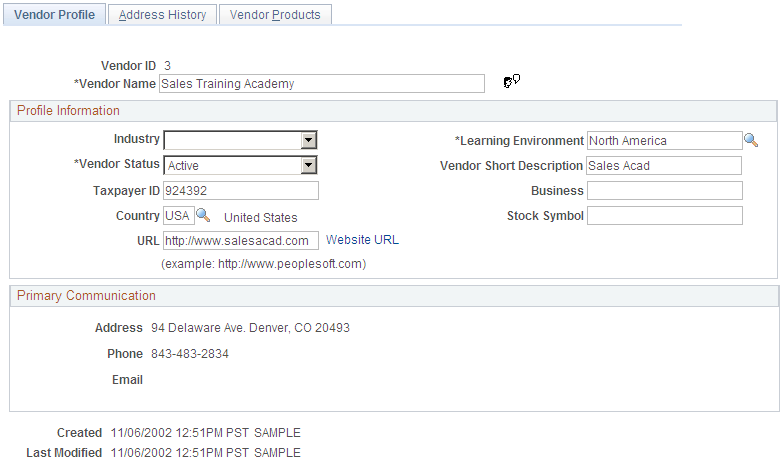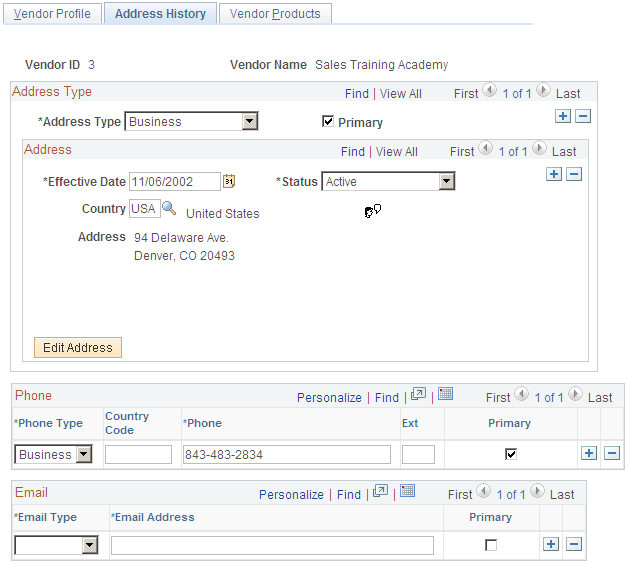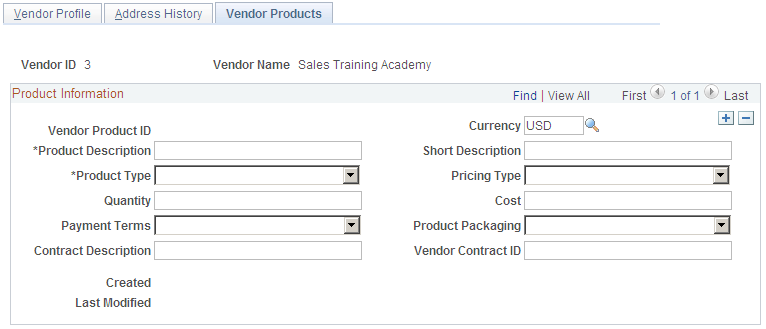Defining Vendors
To set up vendor profiles use the Define Vendors (LM_VENDOR_MAIN) component.
Create a vendor profile for each organization from which you purchase goods and services for classes and programs. All vendor data is manually entered and maintained. You can associate vendors with the instructors, delivery methods, materials, and facilities that you define later.
|
Page Name |
Definition Name |
Usage |
|---|---|---|
|
LM_VENDOR_MAIN |
Define vendor profile information. |
|
|
LM_VENDOR_ADDR |
Define address details specifying the vendor's primary address. |
|
|
Edit Address Page |
EO_ADDR_USA_SEC |
Edit vendor address information. |
|
LM_VNDR_PROD |
Define learning-related vendor product information. |
Before you can set up vendors, you must:
Set up vendor product types.
Set up vendor pricing types.
Set up vendor product packaging types.
Use the Vendor Profile page (LM_VENDOR_MAIN) to define vendor profile information.
Navigation:
This example illustrates the fields and controls on the Vendor Profile page.

Field or Control |
Description |
|---|---|
Learning Environment |
Enter a learning environment to associate with the vendor. Learning environment values are set up on the Learning Environment page. |
Vendor Status |
Select the status of this vendor: Active or Inactive. |
Industry |
Enter the type of industry with which this vendor is associated. Industry values are delivered with the system. |
Country |
Enter the country with which this vendor is associated. Country codes are synchronized from the HR country code table EIP. |
Business |
Enter a business code. |
Stock Symbol |
Enter the vendor's stock symbol, if any. |
Website URL (website uniform resource locator) |
Enter the vendor's website URL, if any. |
Primary Communication
The system displays the vendor's primary communication information, as defined on the Address History page.
Use the Vendors - Address History page (LM_VENDOR_ADDR) to define address details specifying the vendor's primary address.
Navigation:
This example illustrates the fields and controls on the Address History page.

Field or Control |
Description |
|---|---|
Address Type |
Select an address type. Address type values are defined on the Contact Method Type page. |
Primary |
Select to identify an address as primary. Every vendor must have a primary address. |
Effective Date and Status |
Enter the effective date and status for the address. |
Country |
Enter the country for the address. You must enter a country value before you can edit the address. |
Address and Edit Address |
Enter a country value if one is not specified, and click the Edit Address link to add or update the address information on the Edit Address page. |
Phone
Field or Control |
Description |
|---|---|
Phone Type |
Select a phone type. Phone type values are defined on the Contact Method Type page. |
Country Code |
Enter the country for the phone type. |
Phone |
Enter the phone number. |
Ext (extension) |
Enter the phone number extension, if any. |
Primary |
Select to identify a phone number as primary. If you have one or more phone numbers for a vendor, you must mark one as primary. |
Field or Control |
Description |
|---|---|
Email Type |
Select an email type. Email type values are defined on the Contact Method Type page. |
Email Address |
Enter the email address. |
Primary |
Select to identify an email address as primary. If you have one or more email addresses for a vendor, you must mark one as primary. |
Use the Vendor Products page (LM_VNDR_PROD) to define learning-related vendor product information.
Navigation:
This example illustrates the fields and controls on the Vendor Products page.

Field or Control |
Description |
|---|---|
Product Description and Short Description |
Enter a description and short description for the vendor's product offering. |
Product Type |
Enter a product type. Product type values are defined on the Product Types page. |
Pricing Type |
Enter a pricing type model for this product. Pricing model values are defined on the Pricing Types page. |
Quantity |
Enter the number of offerings for this product. |
Cost |
Enter the cost of this product, for one product packaging unit. If you associate this product with a course, the classes for that course inherit the cost that you define here. The amount displays on the Class Costs page and is included in the total estimated costs that also appear on that page. |
Payment Terms |
Enter the terms in which payment for this product is required. Payment terms are delivered with the system as translate values and you can modify them. |
Product Packaging |
Enter the product packaging unit of measure for this product. Product packaging values are defined on the Product Packaging page. |
Currency |
Enter the type of currency for this product. Currency codes are delivered with the system. |
Contract Description |
Enter a brief description of the contract that you have for the product. |
Vendor Contract ID |
Enter the vendor contract ID code, if any. |